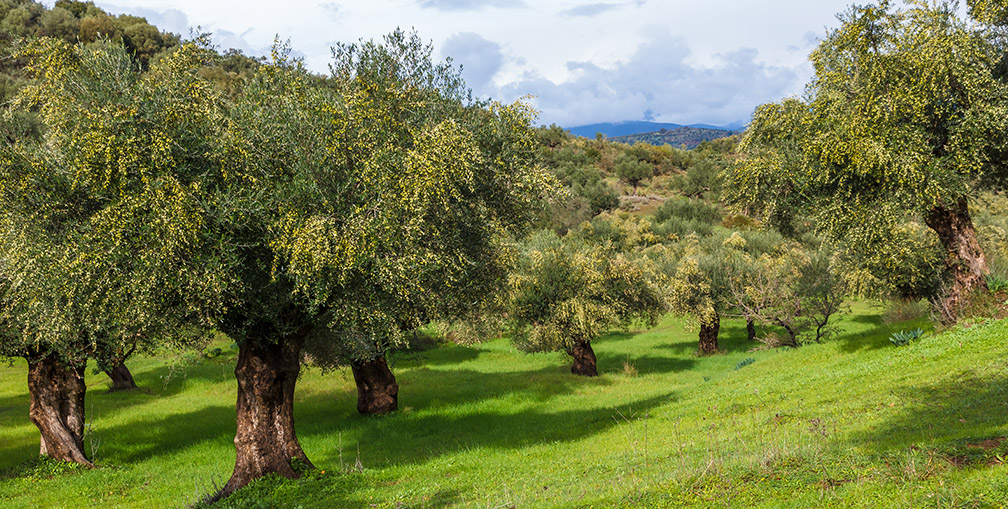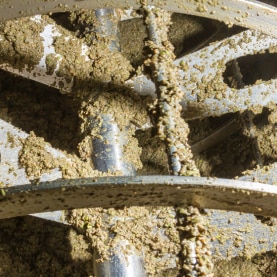Olive oil
Olive oil, originated in the Mediterranean Basin and is believed to have been used for thousands of years. It is still produced in the same geographic area today. Despite competition from other oils, consumption of olive oil is currently on the rise. It is best known for its flavour and nutritional qualities, and can be consumed fresh or used in cooked dishes.
Age-old consumption
Olive oil is a typical product of countries in the Mediterranean region. Olive trees may already have been cultivated in the 4th millennium BCE in Syria, Crete and even in Corsica. In Crete, excavations of the Minoan palace of Malia, which dates from the 2nd millennium BCE, have revealed that storerooms could hold up to 10 000 litres of olive oil, a proportion of which was most likely exported. It was greatly esteemed throughout the whole of Greek and Roman Antiquity.
Olive oil has long been a core ingredient of Mediterranean cuisine. From the 19th century onward, it experienced serious competition from tropical oleaginous oils, such as peanut oil. Consumer health concerns in the 1990s gave it a fresh boost. Olive oil contains a high volume of mono-unsaturated fatty acids, which reduce the risk of cardiovascular disease, and is also a powerful antioxidant and a source of vitamin E. These properties, along with advertising campaigns, sparked the interest of countries where it was not traditionally consumed, such as Germany, Switzerland, Japan and Canada, which began importing more. Global production and consumption continue to increase, even though olive oil only occupies a small place among all the other oils.
Olive oil production
Although China, Australia and the US for example all currently produce olive oil, the main producing countries are still those in the Mediterranean region, from where the olive tree originates. The olive tree belongs to the Oleaceae family, like the lilac; it tolerates poor soil and relatively dry conditions, but dislikes the cold. It flowers in May and June and olives are harvested between September and February. The difference between green and black olives lies in their ripeness, the green ones being harvested before the black ones.
There are many different varieties of olive. The Nyons olive is a black olive from France and is very well known for its high oil yield. Moreover, Nyons olive oil has been granted AOC certification (controlled designation of origin). Five or six kilos of olives are needed to make one litre of oil, depending on the variety and when the olives are harvested. Virgin olive oil is obtained through cold pressing at a maximum temperature of 60°C.
Various criteria determine the quality of oil. Its acidity level is chemically analysed: the lower the acidity, the higher the quality. Extra virgin olive oil has acidity levels of less than 1%, whereas virgin oil may have acidity levels of up to 2%. Organoleptic, or sensory, analysis is used to test the flavour and aroma of olive oil.
Cooking with olive oil
Olive oil is becoming increasing popular because of its flavour and is generally used raw to season salads or fish. It can be used in cooking, although not at high temperatures. The ‘smoke point’ for extra virgin olive oil, in other words the temperature at which oil breaks down and is spoilt, is approximately 190°C, whereas for rapeseed oil it is 240°C.
Olive oil and its qualities
Olive oil has not been used uniquely for its delicious flavour. Throughout Antiquity, it was used as a salve for the skin and many oil lamps bear witness to the role it played in lighting. For many years, Marseille soap was produced using olive oil.
Amouretti, Marie-Claire et Comet, Georges, 1985. Le livre de l’olivier. Aix-en-Provence : Edisud.
D’Amico, Serge, 1997. L’encyclopédie des aliments. Paris : Éditions Fontaine.
Divincenzo, Maria Vittoria, 1988. Les fruits et les légumes. Paris : Éditions Solar.
France agrimer, 2011-2012. Le marché de l'huile d’olive [en ligne]. [Consulté le 8 avril 2016]. Disponible à l’adresse : http://www.franceagrimer.fr/content/download/17461/136571/file/Le%20marché%20de%20huile%20d'olive.pdf
Toussaint-Samat, Maguelonne, 1997. Histoire naturelle et morale de la nourriture. France : Larousse.






